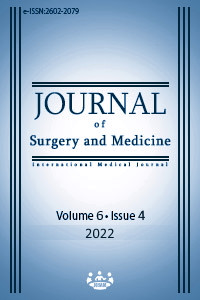Gastrointestinal fistula due to multiple neodymium magnet ingestions
Keywords:
Foreign body ingestion, Gastrointestinal fistula, Magnets, PediatricAbstract
Foreign body ingestion (FBI) is one of the critical conditions encountered in pediatric emergency services. FBI can lead to high mortality in children. Neodymium magnets are increasingly popular due to children’s great interest in them. In cases of multiple magnet ingestion, the risk of mucosal perforation is higher when compared with other types of FBI. With this case, an attempt to raise awareness of this medical problem was made by sharing the case of a neodymium magnet body in a 24-month-old patient. The magnet was detected incidentally during our fever etiology examination although possible ingestion of a foreign body had previously been reported in her medical history. Our patient presented with abdominal tenderness, agitation, and other symptoms. An abdominal X-ray was taken. A foreign body that resembled a neodymium magnet sphere was observed. During surgery, a gastrocolic fistula in the antrum was observed. Multiple magnets are foreign bodies that present a higher risk of causing intestinal perforation compared to other foreign bodies. It is known that multiple magnet ingestions may cause mucosal ulceration, and it should be emphasized that such ingestion may cause gastrointestinal fistulas. Since pediatric patients in a certain age group tend to put objects in their mouths, each patient with an unclear cause of fever and abdominal sensitivity should be questioned with respect to FBI and then tested radiologically.
Downloads
References
Gummin DD, Mowry JB, Spyker DA, Brooks DE, Fraser MO, Banner W. 2016 Annual Report of the American Association of Poison Control Centers’ National Poison Data System (NPDS): 34th Annual Report. Clin. Toxicol. 2017;55(10):1072–252.
Kramer RE, Lerner DG, Lin T, Manfredi M, Shah M, Stephen TC, et al. Management of ingested foreign bodies in children: A clinical report of the NASPGHAN Endoscopy Committee. J Pediatr Gastroenterol. Nutr. 2015;60(4):562–74.
Anselmi EH, Román CGS, Fontoba JEB, González LA, Dieguez EV, González JL, et al. Intestinal perforation caused by magnetic toys. J Pediatr Surg. 2007;42(3):13-6.
Krom1 H, Visser M, Hulst JM, Wolters VM, Van den Neucker AM, Meij T, et al. Serious complications after button battery ingestion in children. European Journal of Pediatrics. 2018;177:1063–70.
Jatana KR, Litovitz T, Reilly JS, Koltai PJ, Rider G, Jacobs IN. Pediatric button battery injuries: 2013 task force update. Int J Pediatr Otorhinolaryngol. 2013 Sep;77(9):1392–9.
Cevizci MN, Karadağ ÇA, Demir M, Dokucu Aİ. Çoklu mıknatıs yutulmasına bağlı bağırsak perforasyonu: Olgu sunumu. Ulus Travma Acil Cerrahi Derg. 2012;18(2):192-4.
Çayırlı H, Genç A, Taneli C, Yılmaz Ö. Çoklu neodmiyum mıknatıs yutulmasına bağlı bağırsak perforasyonu: çocuklar için yeni bir tehlike. Çocuk Cerrahisi Dergisi. 2014;28:49-52.
Downloads
- 320 479
Published
Issue
Section
How to Cite
License
Copyright (c) 2022 Didem Gülcü Taşkın, Zerrin Özçelik
This work is licensed under a Creative Commons Attribution-NonCommercial-NoDerivatives 4.0 International License.
















